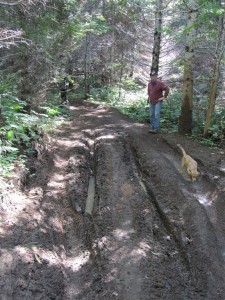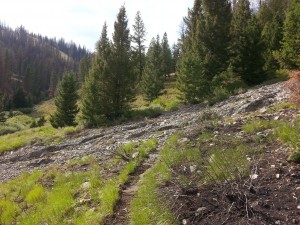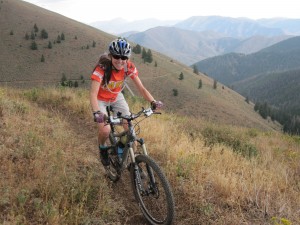Rainy weather is creating conditions that should give you pause as you think about trail travel in the area. Stay off of wet trails and give them time to dry out before planning your next hike or ride. If you get on a trail and find that it is wetter than you anticipated, turn around. Conditions often get wetter as we climb higher and deeper into the forest, so do the right thing and turn back if you are leaving a muddy track.
If you encounter short stretches of wet trail, and feel confident that your passing will not cause resource damage, please do not walk around the wet section of trail. Instead, stay on the trail. When people go around wet areas they help create “braided” trail conditions. In such situations the trail gets wider and wider, or many alternative routes are created through the wet area. It is better to stay right on the trail. If you are on a bicycle it is often best to carry your bike through such areas, while staying on the trail.
Recent storms have changed the condition of many of our local trails. Debris flows have left some trails covered with areas of sand, soil, and rock. Water channeled onto trails has scoured some trail surfaces and made them deeply incised (“V”-shaped). In other places, holes, or drop-offs have developed on trail treads. If you are traveling fast and don’t stop in time, such holes, or rock or soil deposits, could result in a nasty spill. Be extra cautious in your travels, go slowly, and anticipate that you may need to stop quickly.
I was out on the Castle Creek Trail No. 140 yesterday to look over the situation following recent storms. I mention this because the conditions I found on the trail will be found on many of our local fire-impacted trails. The trail was impacted significantly by debris flows, and in places flowing water had channeled onto the trail itself.
The Castle Creek Trail remains open at this time, but like all open trails within the area of last summer’s Beaver Creek Fire, extra care needs to be employed for those choosing to travel them. (FYI – Placer Creek Trail No. 141 remains closed at this time.)
On trails within the burn, trail conditions can go from good to bad quickly, so trail users need to travel more slowly than usual. They need to look ahead, and be ready to stop at a moments notice to avoid hitting dangerous drops in the trail tread, or to avoid running into rocks or soft tread conditions.
If you are in the burn, be ready for highly variable conditions and situations where passing may be difficult, or depending on your mode of travel, even impossible. Check the weather forecast and keep an eye to the sky. Stay out of the area if the weather conditions suggest that rain is on the way. Be mindful of all of the dead, standing trees that exist trail-side in the area of the burn. Winds and other weather conditions can make these trees even more unstable, and the threat of falling timber needs to be considered and guarded against.
Please help take care of the trails, and play it safe so that you can enjoy many more smile-miles.



